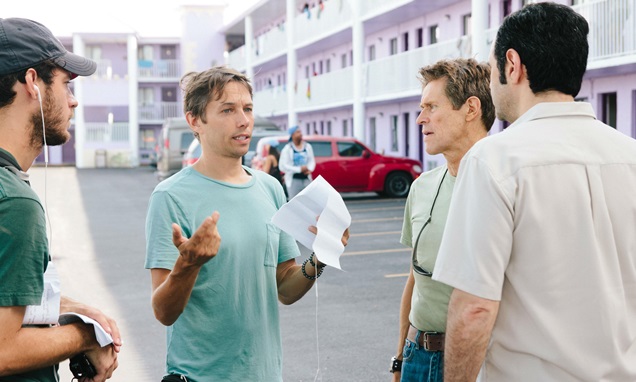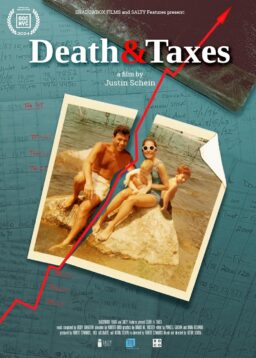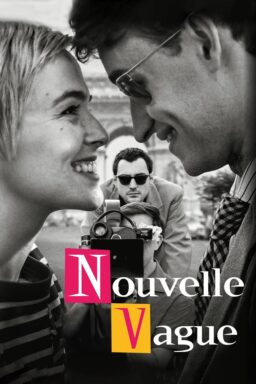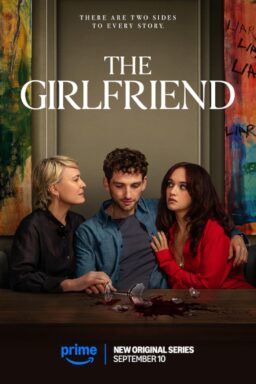Sean Baker’s “The Florida Project” takes place over the course of one summer, and is presented through the eyes of young kids living in colorful motels not far from the Magic Kingdom of Disney World. Brookynn Prince stars as the capricious Moonee, who along with her friends Scooty (Christopher Rivera) and Jancey (Valeria Cotto), are up to little good throughout the motel property. Meanwhile, the adults on the property face experience various stresses, like Willem Dafoe’s manager Bobby and Moonee’s young mother Halley (Bria Vinaite), who isolates herself from her friends in the motel and struggles to pay for her room. Captured with both the documentary style of Baker’s previous film “Tangerine” (which was shot on an iPhone) and a very cinematic eye, “The Florida Project” is an immersive, incredible look at different lives, whether those of the freewheeling children or the worn-down adults, that directly juxtapose the quaint fantasy being sold by the billion dollar amusement park just down the street.
RogerEbert.com sat down with Baker to talk making his new film, the casting of Brooklynn Prince and Willem Dafoe, creating a fantasy land out of a location decimated by the recession and more.
There’s not many movies that start with “Celebration,” and yet it has a great effect on this movie. Where did that idea come from?
Well, first off it’s just such a classic song. It’s sort of a timeless song. And I don’t know if you know that right next to Kissimmee is the town of Celebration. And when you think of the parks, there’s just a celebratory world that you’re entering. We were working obviously and focusing on an extreme juxtaposition between homeless children and a place that the world associates with children and being made for children. The song was was simply a way for us, showing the audience—even if they’re not going to pick it up at first—that we’re headed down a road which, and I don’t mean this in a cynical way, that there’s going to be a lot of irony here and a lot of juxtaposition.
And it’s kind of bombastic in a party way, like the party of the movie.
Exactly, and that’s the way she lives her life, little Moonee. And then of course we do that orchestrated version of it at the end. And I have to thank my co-screenwriter for that, because that’s completely Chris Bergoch. We didn’t script that, and then in post-production—I edit consecutively, in order, almost like a fine cut, I don’t even do a rough cut or an assemble, I go right in—and we were months into the edit and getting to the end, and he was like, “Did you ever consider doing an orchestrated ‘Celebration’ at the end?” and I was like, “thank you!” because first I thought I was going to be doing some sort of sound-scape-y, sounds of the park and laughter.
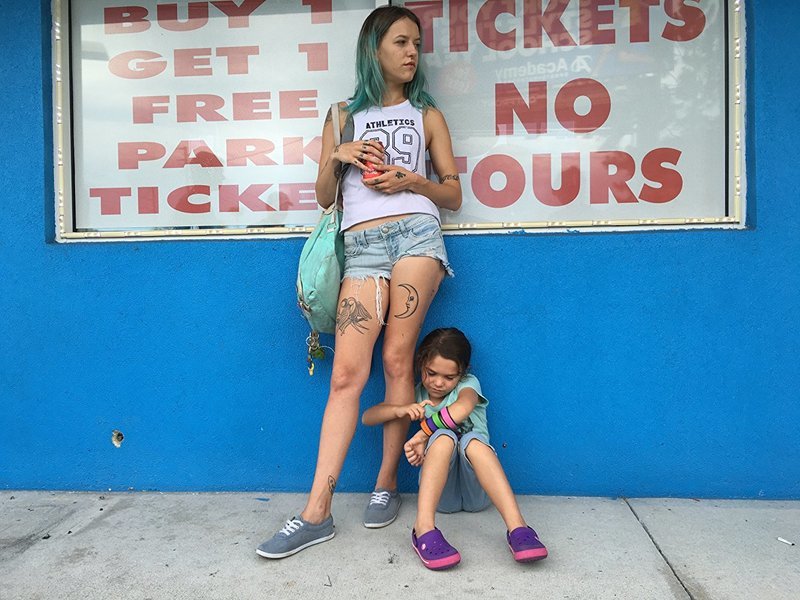
So, you cut the film consecutively. How did you trim this down? What were your values when it came to what you wanted to keep, especially when it comes down to atmosphere, or time?
Actually, to tell you the truth, when we edited we ended up keeping those little moments, almost just the slice of life moments that we would consider extraneous. We ended up keeping more of those than the expositional scenes. Every time we went to a full scene of exposition, or a full scene that just had too many adults in it, it took us out. We actually didn’t overshoot a lot of those slice of life moments, we used almost every one of them that we had in the film, and we actually wanted more of Willem doing his menial work. But to tell you the truth, it was a crazy production and we were running out of time and had very little hours. But we had many more scenes that focused on the procedural, which we wrote knowing that we could always take away. Chris and I aren’t precious, it’s about whatever works ultimately in the edit. But I have to tell you, we actually have a whole scene that we cut in which you understand exactly how the DCF goes about an investigation with the kid, there was a whole other scene where they’re explaining to Haley in detail what she has to do to keep her kid. But it was stuff that was ultimately unnecessary.
And then on top of that, because it’s not seen through the eyes of a child but we’re definitely trying to have the audience almost spend the summer with her and be one of the gang, and therefore it’s about how much they’re absorbing as well, and how much they see. We realized during our edit that we were OK with cutting some of the exposition out. And then we’d have some people on our team saying, “Shouldn’t the audience understand a little bit more about why they have to move out every 30 days?” And I’m like, you know what, if the audience is interested in that, which I hope they are, let them do their homework on it. Trust me, there’s plenty of information on it. It’s something that I hope will spark homework. I don’t want to impose it, but hopefully you embrace Moonee and her mom and the kids enough where you want to think about the real Moonees and how they’re living and et cetera.
And even the way the camera shoots them, it’s like you’re supposed to bring your adult perspective to it, I suppose.
That is one thing we did decide on early on, I don’t think you’re ever looking down on the kids. I don’t think there’s one shot in the film where you look down, it’s always eye-level or looking up and making them tall and the king of their world.
How did you achieve that?
We had our little dolly that could really get the camera as low as possible, and we had a lot of Steadicam, and our Steadicam guy would ride it low all of the time. We were lucky enough to work with those two guys from Miami, Osvaldo Silvera Jr. and Mike McGowan, both guys who worked on “Moonlight.” That opening “Moonlight” 360 thing, those were the guys who did our Steadicam shots. They were incredible. And sometimes when I was in a bind where I had to improvise behind the camera as well, with the cranes, that was one of those moments where we had to shoot that as fast as possible, they’re an endangered species, we’re not allowed to touch them or to feed them, so literally I just saw, “Willem, act!” And so he does this thing where he’s shooing them away, and our Steadicam guy just gives me that nice move up. I think we were all just in a moment where we were like, capture this!
And there are other moments. Like when Willem is walking out of the hotel office with the sunset in the distance as he makes a finger gun gesture towards the kids. I don’t know how you caught those moments.
That’s actually one of those Alexa moments. We knew that the sun was coming, we were all calculating how it would be, and then the moment he does that, it just happened to be like “and it’s going to work … now!”
It comes very naturally. Your movie is a good mix of composed shots like the large hotel exteriors and then natural, on-the-fly moments.
Yeah, we tried to mix it up. I have done plenty of that docu-style in my career, but I’m starting to miss the more controlled approach to filmmaking, because it’s weird. I haven’t talked about this before, but it’s a weird time because our iPhones have stabilization on it now, so now the new generation is getting used to very fluid, almost Steadicam shots in their YouTube videos and their homemade selfies. So I wonder how the whole handheld era will even play in ten years from now. We’ll be like, “why is that camera shaky?” Actually, to tell you the truth, the docu thing might going away in terms of audiences even understanding what that means. But Alexa is also great with framing, and we were working with a 2:35 aspect ratio, and real beautiful Panavision anamorphics.
Your shots of various stores like the gift shop or the ice cream stand have those great wide angle lenses.
Yeah, they’re the series E, so it was like around the early ‘80s, probably around the Spielberg era. Flares that weren’t too heavy. I wanted to take advantage of these locations and show them as wide as possible, and Alexis always goes to the wide. So it’s very rare in the film that we have any Telephotos, we have some Telephotos with them selling perfume. But even that is not that close, even with the Telephoto.
Your movies are usually about very specific time and place, like “Tangerine” specifically being by the Donut Time in Los Angeles, at Christmastime. How important is setting to you when you’re envisioning a story as a director?
I think it’s up there just as important as the topic we are covering. I mean sometimes it even inspires the topic we are covering. “Tangerine” was all about the location, because we didn’t know anything about that world, [“Tangerine” co-writer Chris Bergoch] and I are two cisgender white guys from outside that world, we didn’t want to go in there and just say “here’s the script, guys,” we wanted to go in and learn about the world before writing the script. It all stemmed from that we wanted to make a movie about Donut Time. And that was one of those caveats where I said, “guys, I’m not going to make this movie unless we get Donut Time.” Because it would lose its authentic, everybody from that area would just be like, “this isn’t authentic, this isn’t real.”
And the same thing happened with “The Florida Project,” where we knew we wanted to tell a story about this area, and the fact that this area comes with, Route 192 is just lined with these colorful, small businesses, whether they are budget motels or ice cream stands. They’re basically very tourist-targeted, and at one time they were thriving tourist motels, and then of course, the recession of ’08 really decimated the area in terms of the housing crisis that followed right after. You have these basically motels that were built and made to be tourist motels, they are actually now welfare hotels. But they still retain the color and that real kitsch sort of, where it’s obviously ripping off Disney and the themes of the parks in order to attract tourists. It’s a weird juxtaposition that you’re living in this fantasy land, and everything is but a fantasy.
It reminds me of Rene Claire’s “Forbidden Games,” that sense of “do these kids not know life sucks? A war is happening around them.”
Oh, yeah.
That film is more cynical, but your film has the air of seeing the pregnancy sign near the motel and the gun shots.
Oh, you picked up the pregnancy sign. You’re one of the first people to mention that. In pre-production, we tried to watch as many children-oriented films as possible. We had already seen most of them but we wanted to revisit, just to see how the masters tackled the subject, but also what to avoid. I don’t want to ever … like with “Starlet,” we intentionally did not look at “Boogie Nights” before making “Starlet,” and I should have. Because there are one or two scenes that come too close and it looks almost like—because it’s about the same industry and you’re going to be covering certain subjects.
But this time we made sure that we watched “Kes,” “Small Change,” a ton of “The Little Rascals.” And then more obscure foreign films, “Streetwise.” There was actually a Korean film that we were looking at for the child performances called “Miracle on 1st Street.” There were lots of sort of films that we were looking for inspiration, but also for what to avoid.

Was it terrifying resting your movie on child actors?
Actually, to tell you the truth, no. Because I always take a long time with casting. I mean, casting is a movie. A movie will live or die with your casting. Like I said with Donut Time before, the same thing with this film, I said I will not make this film and the producers were getting scared. I said “You better be prepared to shut down unless we find the present day Spanky McFarland. I will not make this film unless we find Spanky.” And then Brooklynn walks into the room, and she’s like the new Spanky, and she’s so incredible. But I was naive because I was expecting that if I couldn’t get the performances I would just manipulate the performances with editing. I would get enough coverage. And I’ve done that plenty of times where a scene won’t work but I can use a cutaway and then suddenly people will think, “That’s a brilliant performance!” and it was just a person looking at a phone. But I thought I was gonna do that, but then I brought on Samantha Quan who is our acting coach, and she made what I consider like a summer camp for the kids. They had fun, they were doing workshops, they were doing exercises and activities so it never seemed like work. And it got them to a place whee I could actually, and Brooklynn especially she’s so professional, she would be, you could run a five-minute scene on her and not have to cut. I was naive thinking I could go into this without that. Kids are kids, they still need handholding no matter how trained they are, they need to b told what to do. They need to learn lines and understand blocking. You can’t just say, “I want you to walk from here to there and deliver your line.” I need you to do this [stands up, walks over to one part of the room] “1, 2, 3, 4, and then say your line.” You actually have to do that, but you have to get them comfortable enough where it doesn’t look like they have been practicing it, and then I ask them to improvise. And Brooklynn was always wonderful about that, her energy level was always there, her enthusiasm was always there. She was actually upset everyday when she had to go home.
That’s a compliment to you, and your set.
I think even her parents were like, “she wants to stay! Let’s do it.” But child labor laws are trouble. Get her out of here [laughs].
How did Willem Dafoe fit into this?
He’s incredibly transformative, and he’s up for anything and wants to experiment. I think when he signed onto the film, to tell you the truth, that he probably thought he was getting into a “Tangerine” thing. He saw “Tangerine” and liked it, and probably thought I was shooting a new film on an iPhone, but when I met him over coffee, I explained to him that we were shooting 35mm, that this was going to be more conventional. But he was very patient, he was down for anything, he was dealing with all six-year-olds and eight-year-olds and first-timers, so imagine that. Only when he was working with Karren Karagulian, Macon Blair and Caleb Landry Jones, those were the only times when he could just be in a comfort zone where seasoned actors just doing their things. Shooting their stuff was so fast.
When [Dafoe and Jones] move the ice machine.
That was like four takes, and all four takes were great. It came down to the little tiny details.
Why did you decide to cast Caleb Landry Jones in what must be one of his first normal roles? He’s so handsome.
The first time I saw Caleb, which was in “Antiviral,” I was thinking that someone is going to have to cast him as Dafoe’s son one day because they look so similar. So basically, we were thinking about a brother character with Bobby, and then suddenly we started to say that we are working with parental themes, and so we brought in the son. And then it was Caleb. And he worked with Josh and Benny [Safdie] and they said he was awesome.
If he could handle a Safdie set, I’m sure he could handle one of yours.
Exactly.
Before I leave, I have to ask—did you color correct the purple castle? It looks incredible in the film.
Everything is just enhanced maybe just a hair. But it’s that crazy saturated.

